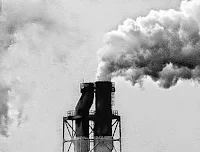Injecting carbon dioxide (CO2) deep underground and turning it into rock may be a potentially viable way to tackle increasing greenhouse gas emissions in the fight against climate change, an international team of scientists said Thursday.
The study, published in the U.S. journal Science, showed for the first time that CO2 injected into volcanic bedrock reacts with the surrounding rock, forming environmentally benign minerals at a speed faster than anyone had predicted.
Capturing and storing CO2 underground, such as in abandoned oil and gas reservoirs, is widely considered a crucial strategy for meeting CO2 emission reduction targets, but doing so creates a risk of carbon leakage.
So attention has now turned to the mineralization of carbon to permanently dispose of CO2, a process scientists previously thought would take several hundreds to thousands of years.
But the new study, led by Columbia University, University of Iceland, University of Toulouse and Reykjavik Energy, now demonstrated that it can take as little as two years.
"Our results show that between 95 and 98 percent of the injected CO2 was mineralized over the period of less than two years, which is amazingly fast," Lead author Juerg Matter, Associate Professor in Geoengineering at the University of Southampton, said in a statement.
The new project called CarbFix was started in 2012 in Iceland, a volcanic island made up of 90 percent basalt, which is formed by volcanic activity and rich in elements such as calcium, magnesium and iron that are required for carbon mineralization.
The gas was dissolved in water and then injected into a deep well at Iceland's study site. On contact with the target storage rocks, at 400 to 800 meters under the ground, the solution quickly reacts with the surrounding basaltic rock, forming carbonate minerals.
"Carbonate minerals do not leak out of the ground, thus our newly developed method results in permanent and environmentally friendly storage of CO2 emissions," said Matter, who is also adjunct senior scientist at Lamont-Doherty Earth Observatory, Columbia University.
"On the other hand, basalt is one of the most common rock type on Earth, potentially providing one of the largest CO2 storage capacity," Matter said.
CarbFix was a relatively small test, so the team's next step was to upscale CO2 storage in basalt.
According to the study, this is currently happening at Reykjavik Energy's Hellisheidi geothermal power plant, where up to 5,000 tons of CO2 per year are captured and stored in a basaltic reservoir.
One main stumbling block facing the new approach is the water required -- about 25 tons for every ton of CO2, but the team said in many places seawater could be used.
Overall, storing CO2 as carbonate minerals significantly enhances storage security which should improve public acceptance of carbon capture and storage as a climate change mitigation technology, it said.
[Xinhua -china.org.cn]
10/6/16
The study, published in the U.S. journal Science, showed for the first time that CO2 injected into volcanic bedrock reacts with the surrounding rock, forming environmentally benign minerals at a speed faster than anyone had predicted.
Capturing and storing CO2 underground, such as in abandoned oil and gas reservoirs, is widely considered a crucial strategy for meeting CO2 emission reduction targets, but doing so creates a risk of carbon leakage.
So attention has now turned to the mineralization of carbon to permanently dispose of CO2, a process scientists previously thought would take several hundreds to thousands of years.
But the new study, led by Columbia University, University of Iceland, University of Toulouse and Reykjavik Energy, now demonstrated that it can take as little as two years.
"Our results show that between 95 and 98 percent of the injected CO2 was mineralized over the period of less than two years, which is amazingly fast," Lead author Juerg Matter, Associate Professor in Geoengineering at the University of Southampton, said in a statement.
The new project called CarbFix was started in 2012 in Iceland, a volcanic island made up of 90 percent basalt, which is formed by volcanic activity and rich in elements such as calcium, magnesium and iron that are required for carbon mineralization.
The gas was dissolved in water and then injected into a deep well at Iceland's study site. On contact with the target storage rocks, at 400 to 800 meters under the ground, the solution quickly reacts with the surrounding basaltic rock, forming carbonate minerals.
"Carbonate minerals do not leak out of the ground, thus our newly developed method results in permanent and environmentally friendly storage of CO2 emissions," said Matter, who is also adjunct senior scientist at Lamont-Doherty Earth Observatory, Columbia University.
"On the other hand, basalt is one of the most common rock type on Earth, potentially providing one of the largest CO2 storage capacity," Matter said.
CarbFix was a relatively small test, so the team's next step was to upscale CO2 storage in basalt.
According to the study, this is currently happening at Reykjavik Energy's Hellisheidi geothermal power plant, where up to 5,000 tons of CO2 per year are captured and stored in a basaltic reservoir.
One main stumbling block facing the new approach is the water required -- about 25 tons for every ton of CO2, but the team said in many places seawater could be used.
Overall, storing CO2 as carbonate minerals significantly enhances storage security which should improve public acceptance of carbon capture and storage as a climate change mitigation technology, it said.
[Xinhua -china.org.cn]
10/6/16

No comments:
Post a Comment
Only News